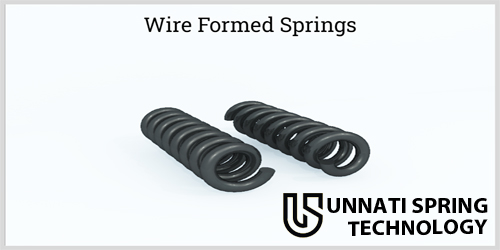
Wire Forming: What Is It? How Does It Work? Types & Uses
Wire forming is a way for making use of pressure to extrade the contour of cord with the aid of using bending, swaging, piercing, chamfering, shearing, or different strategies. The diverse strategies for cord forming can produce any kind of shape, form, or configuration. The method begins offevolved with coiled cord this is straightened earlier than being formed.
Methods Used for Wire Forming
Though there are numerous sorts of device used to carry out cord forming, in maximum cases, cord forming machines are manually or mechanically operated. Manual machines consist of ones which might be operated with the aid of using guide pressure and ones which might be digital however manually loaded. Automatic machines have superior pc numerically controlled (CNC) programming and entire manufacturing with out guide involvement.
Methods For Wire Forming
Wire forming is done the use of numerous exclusive techniques every designed to gain a exclusive shape, pattern, or configuration. The techniques of cord forming are used for different element manufacturing however had been adjusted for cord forming.
Manual Wire Forming:
The oldest technique for cord forming is operated by hand machines, which includes a hand lever and spindle. Manual machines may be drawn or rotary die and feature gears that growth the carried out bending pressure.
Coil Wire Forming:
Coil, or spring cord forming, includes winding cord round a metallic blank. It is likewise used for the manufacture of electrical coils wherein a conductive cord is lightly wound round a ferromagnetic core. Coil winding takes exclusive paperwork relying at the very last product. Electrical coils must be greater exactly wound than springs and might require multiple winding.

Roll Wire Forming:
Roll forming is a price green approach for the manufacturing of flat, round, and different shapes of cord elements. The manner can manufacture undercuts, knurls, pointing, chamfers, grooves, floor finishes, collars, and threads. Roll fashioned cord elements have more energy after being hardened, having rounded edges, and being prefinishing.
Bend Wire Forming:
In the cord bending manner, cord may be formed into limitless configurations to in shape any application. Diameters of 0.four mm to sixteen mm, or 0.016 in to 0.625 in, may be without problems fashioned. Since the bend withinside the cord is made previous to the cord being cut, the manner has no scrap or waste and does now no longer want secondary finishing.

Fourslide Wire Forming:
Fourslide forming or stamping makes use of the identical procedure as a horizontal stamping press with the addition of cams. Along with the cams, the system has shafts, an electric powered motor, a die, a press, and sliding gear. The procedure has 4 sliding gear that shape the twine from 4 sides. The cam regulates the motion of the 4 gear, which permits the procedure to have vertical motion, including punching, with horizontal motion in numerous directions.
Hydraulic Wire Forming:
In a hydraulic twine forming system, a hydraulic motor is used to power the shaping rollers. A servo motor and CNC programming software the system to the desired configuration. Wire shapes are routinely discharged from the system after the finishing touch of the operation.
Pneumatic Wire Forming:
In the pneumatic procedure, twine is fed into the straightening system, shaped to the desired shape, and pneumatically reduce to the right length.

CNC Wire Bending:
CNC twine bending machines may be pneumatic or hydraulic for green and speedy production. They can bend and form rebar to 180o the usage of unmarried or double twine. The system straightens the bar previous to the bending process. CNC machines have top notch accuracy and reduce twine to the precise required dimensions. The styles of twine a CNC system may be programmed to form consists of music, tough drawn, fundamental or covered metals, three hundred collection stainless steel, brass, and beryllium copper. Wire diameters range among 0.008 in to 0.250 in or 0.0203 mm to 6.35 mm.

Types of Wire Forms
The wide variety of twine shapes, configurations, and paperwork is countless in view that new ones are continuously being developed. Wire forming can produce any form possible from complicated tricky three dimensional designs to easy hooks and springs. Many of the matters we use have concerned a few shape of twine forming.
Types of Wire Forms
Springs:
Of all of the forms of twine paperwork, springs are the maximum not unusualplace and extensively used. They are a coil that has been wound right into a tightly wrapped spiral to fulfill preset anxiety requirements. The sort of spring relies upon on how it will likely be used and its application.

Utility Hook:
Utility hooks have a threaded give up and hook, which permits for clean installation. A application hook calls for more than one bends throughout the producing manner which include an offset bend to each facets of the loop with a bend on the give up of the loop that touches the alternative side.
S Hook:
Both ends of a S hook are bent to shape the S shape. They are usually used for striking garage or for organizing cables, hoses, and cords as a protection measure.
Wire Displays:
Wire shows are a long lasting and less expensive method for showing products. They are produced through bending, shaping, and forming cord made from low, medium, or excessive carbon metallic however also can be made from stainless metallic, copper, and aluminum brass. Once they may be cord formed, they may be covered, plated, or painted.

- Basic and Other Equipments used for Manufacturing of Springs
DETAILS |
SPECIFICATIONS |
Compressible as well as Tension Machine |
(Automatic Coiling 0.15 mm to 4.00 mm) |
Torsion machine |
(Automatic Coiling 0.33mm to 3.00 mm) |
Wire Forming |
(Automatic Bending) to 0.50 to 2.00mm |
Sping Load Testing Machine (Digital) |
(.01 grams to 10.00 kg.) |
Sping Load Testing Machine (Manual) |
(.01 grams to 100 Kg.) |
Automatic Grinder |
(Automatic Grinding 0.70mm to 3.00 mm) |
Order Now

